Small Red Bump on Baby Shoulders and Face.
Practically every parent knows that babies have very sensitive skin, making them more prone to rashes than adults and older kids. But what you may not know is exactly what that baby rash is, what's causing it or how to treat it. Seeing a red or bumpy reaction on baby's skin can be alarming for parents, likely conjuring up questions for you like, is baby uncomfortable? Are they itchy or in pain? And how exactly do you know if baby has a harmless diaper rash or something more serious?
Because there are so many different kinds of baby rashes, it's important to know what symptoms to look out for and when to be concerned. To help you better identify a baby rash on the body, we've provided a handy guide to all things rashes. Read on as we break down the common types of baby rash, tell-tale signs and symptoms, and what the best remedies are.
In this article:
Baby rash causes
baby acne or baby rash?
Baby heat rash
Meningitis rash
Strep rash
Chicken pox
Baby drool rash
Baby eczema rash
Hives
Baby allergy rash
Baby fungal rash
Cradle cap
When to be concerned about baby rashes
Baby Rash Causes
When it comes to baby rashes, there are many types and many culprits. Some common causes include:
• Irritants. Common irritants that can bother baby's sensitive skin are saliva and drool, poop, baby wipes, detergents, soaps, sunscreen and nickel.
• Allergies. Allergic reactions can cause a baby rash to appear in a bunch of different forms. Rashes can be itchy, welt-like hives or dry, itchy patches. Eczema is the most common version of a baby rash caused by allergies.
• Infections. Infections can lead to different types of baby rash, the most common of which are fungal rashes. Sometimes, however, a viral baby rash can develop. "These rashes occur when babies have specific viral illnesses and may be associated with fever or other symptoms," says Anna Bender, MD, a pediatric dermatologist at Weill Cornell Medicine and New York-Presbyterian. A viral baby rash can appear as small dots on the torso and sometimes arms and legs, and can last for several days to a week. It may spread for a few days and then begin to clear up.
"Baby's skin barrier is especially fragile because it's thinner, immature and the skin is still developing, so that makes it a lot more vulnerable to damage and dryness. It's also more reactive, especially to things that could be irritants," explains Lauren R. Crosby, MD, FAAP, a pediatrician at LaPeer Pediatrics in Beverly Hills, California. Baby's skin is typically ultra-sensitive from birth until around age 2, although diaper rash can continue to rear its head past that age until kids are potty trained.
In our guide below, we outline the different ways baby rashes look and behave. Keep reading for the most common types of baby rash to keep an eye out for, plus how to prevent and treat them. From heat rashes to chicken pox, we help make sense of any bumps or blotches you may find on baby.
Baby Acne or Baby Rash?
Breakouts aren't just for teenagers—it's actually totally normal for babies to get acne. "Also known as neonatal acne, it's a common rash in babies during the first month of life," Bender says. "It's thought that maternal hormones—those that pass from mother to baby in utero—may cause baby acne to flare."
But how can you tell if it's baby acne or a baby rash? Baby acne typically looks like a bunch of small, red bumps, as opposed to the lacy red of a baby rash.
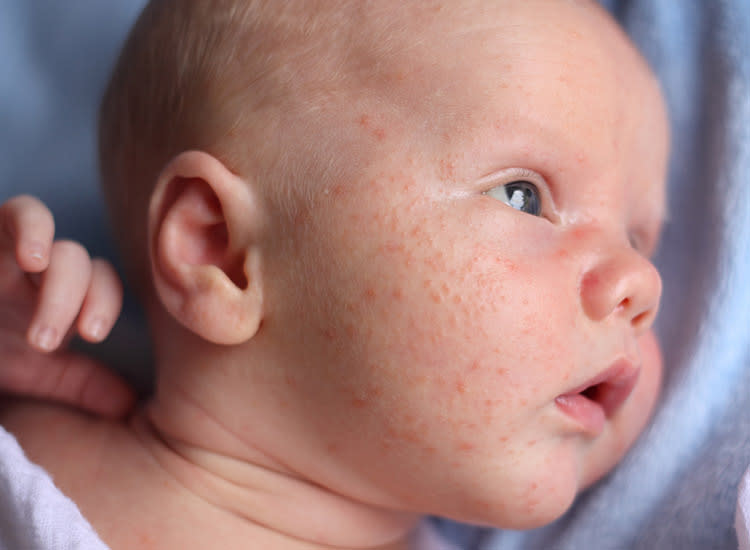
Image: iStock
Baby acne symptoms
• Pimples. Baby acne usually involves clusters of tiny red pimples and whiteheads.
• Irritated cheeks. Baby acne usually develops on the cheeks, but it can also appear on baby's nose, forehead and sometimes behind the ears and on the scalp.
• Persistent symptoms. Baby acne can last up to three to four months.
Prevention and treatment
Usually, baby acne clears up on its own with gentle cleansing. Once in a while parents might need to see a dermatologist if it's persisting beyond the normal three to four months, but that's pretty rare.
Baby Heat Rash
Baby heat rash tends to happen when baby's sweat glands become blocked and trap sweat under the skin, Crosby says. It's usually seen in warm weather or when baby is overdressed. How do you know if the baby rash is caused by heat?
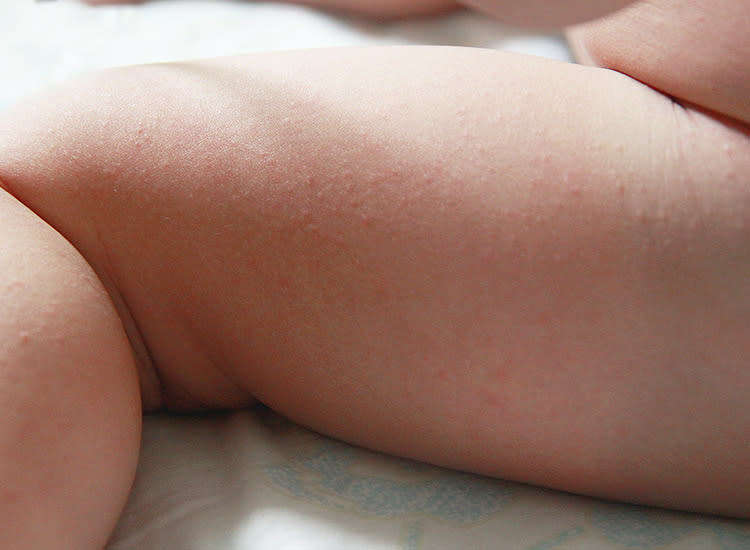
Image: Shutterstock
Heat rash symptoms
• Tiny red bumps. These typically appear on baby's head, neck and shoulders, and sometimes on the chest.
• Itching. Sometimes heat rash can be itchy, so take note if baby is scratching at their irritated skin.
Prevention and treatment
To prevent baby heat rash, dress baby in lighter clothing to make sure they aren't getting overheated or sweaty. In warm climates, it's fine to let them sleep in just a onesie and diaper, and run a fan in the bedroom to keep the air cool and circulating. When baby heat rash does strike, "I recommend a daily bath with a non-fragrant sensitive skin cleanser to help clear out the sweat and keep the skin clear," Crosby says. A baby rash from heat usually goes away on its own in three to four days, as long as baby isn't overdressed and stays in a cool environment.
Baby Diaper Rash
It's pretty self-explanatory where you can expect to see this baby rash. "Diaper rash can occur due to irritation from wet diapers and friction," Bender says. Baby diaper rash is even more common in older babies who sleep through the night longer and may have wetter diapers in the morning.
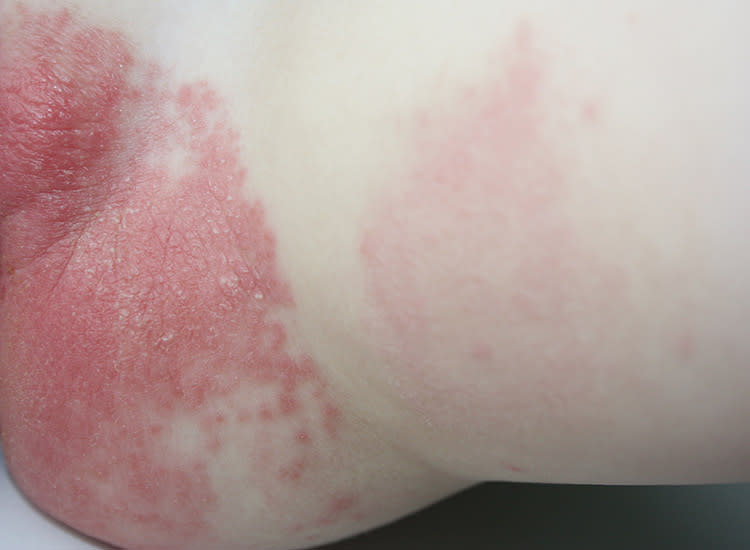
Image: Shutterstock
Diaper rash symptoms
• Red patches. These typically appear on the rounded part of baby's bottom.
• Puffy, warm skin. In some cases, baby's skin may be slightly raised and feel warm to the touch.
Prevention and treatment
"Diaper rash can improve with frequent diaper changes and use of over-the-counter diaper paste containing zinc oxide, which helps in acting as a barrier to prevent friction and irritation in the diaper area," Bender says. Ward off baby diaper rash by making sure the skin is completely dry before you put on a fresh diaper. In the past, baby powder was the go-to trick for absorbing moisture and protecting baby's skin, but doctors no longer recommend using powder for diaper rash, since inhaled powder can irritate baby's lungs.
Sometimes a rash on baby's butt can actually be a yeast rash caused by fungus that lives on our skin.
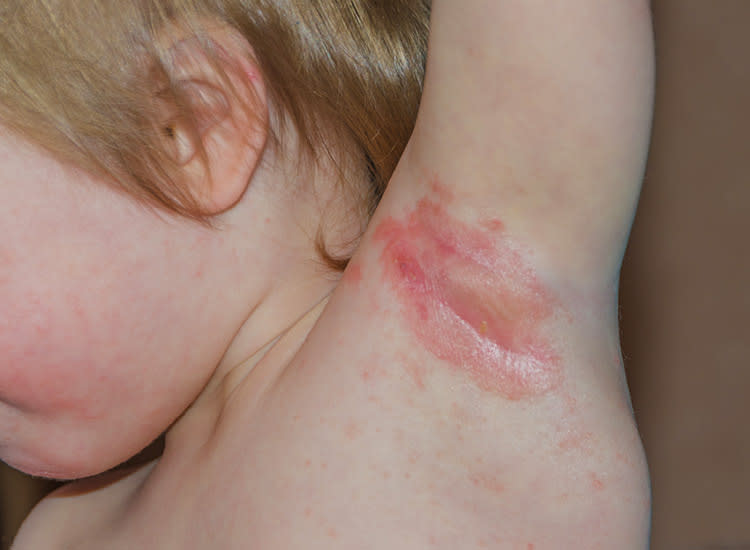
Image: iStock
Yeast rash symptoms
• Pink patches. These patches usually appear in baby's skin folds, accompanied by small pink dots or pustules around the edge.
Prevention and treatment
To treat a baby yeast rash, apply a topical, over-the-counter antifungal cream a few times a day. Prevent yeast rash by keeping baby clean and dry.
Meningitis Rash
Meningitis is when the lining around the brain and spinal cord (the meninges) is inflamed, and "is a serious infection because it can be present in the blood and brain and cause organ damage, permanent brain damage or death," Bender says.
While the viral form of meningitis is serious, it's almost never life-threatening, according to the Centers for Disease Control and Prevention (CDC). Bacterial meningitis, however, can be deadly and calls for immediate medical attention. There's a vaccine for bacterial meningitis, but it typically isn't given until later in childhood or before college. You can't tell the difference between a baby rash caused by bacterial or viral meningitis, and in many cases a rash won't appear at all.

Image: iStock
Meningitis symptoms
• High fever. Take baby's temperature, since a high fever is a classic sign of meningitis.
• Lethargy. If baby is less active than usual, it could be another signal of meningitis.
• Vomiting. This symptom is more common in infants, along with a loss of appetite and irritability.
• Rashes. Meningitis rashes can vary in appearance, but the most common ones include pink or red dots all over, purple rashes that can look like tiny bruises or broken capillaries in the skin, and an itchy, red rash.
Prevention and treatment
Viral meningitis usually clears up on its own in seven to 10 days, but bacterial meningitis requires immediate medical attention so antibiotics can be given as soon as possible. Serious cases may call for hospitalization. If you think baby might have meningitis, call your doctor right away—she can determine if baby has the disease and the type of meningitis.
Strep rash
A strep rash on baby is another type of viral baby rash. Your child is more prone to strep rash if other family members have been exposed to strep throat.
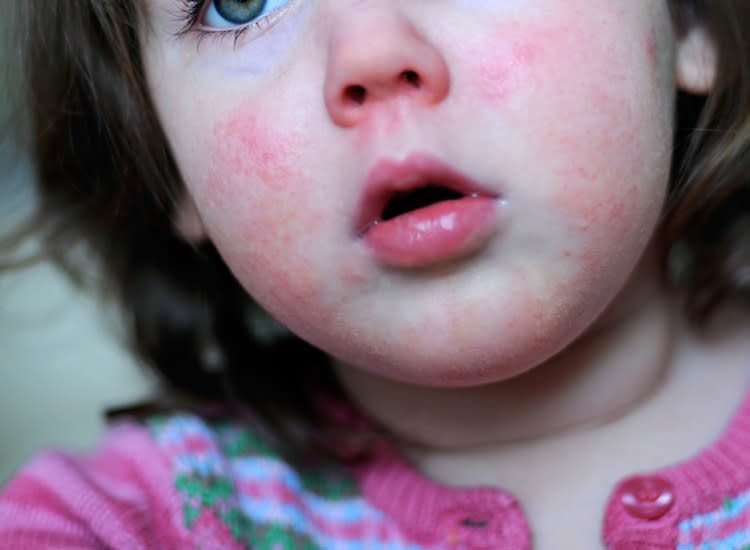
Image: iStock
Strep rash symptoms
• Bright red skin. Strep rash on baby can be bright red and beefy-looking with wet, oozing patches in neck folds, or as a bright red circle patch in the area around baby's anus, Bender says.
• Blisters and scabbing. Spotting scabs and blisters on baby's skin is another common sign of strep.
Prevention and treatment
Since strep can spread from person to person through close contact, keep baby away from infected people. Unlike your run-of-the-mill neck rash, which can be treated with over-the-counter antifungal creams, strep requires a visit to the doctor. Once the diagnosis of strep rash is confirmed—typically with a skin swab test—your pediatrician may prescribe an oral antibiotic as treatment.
Chicken Pox
Chicken pox appears as a baby rash on the body. Before the chicken pox—or varicella—vaccine became available in 1995, practically every child came down with chicken pox before age 9, according to the American Academy of Pediatrics (AAP). Nowadays, it's pretty rare for babies to get chicken pox, thanks to the vaccine. It's a super-contagious viral infection caused by the varicella zoster virus, so avoid contact with infected people to keep baby safe.

Image: Shutterstock
Chicken pox symptoms
• Red bumps and blisters. Chicken pox causes a blister-like baby rash on the skin, starting on the back, tummy or face and spreading all over baby's body. The blisters are often in different stages of healing, so some may look like pink bumps, some look like scabbed bumps and others may look like blisters.
• Itchiness. Chicken pox rashes are renowned for their intense itchiness.
• Fever. A temperature of 101 to 102 degrees Fahrenheit is common with chicken pox.
Prevention and treatment
Doctors recommend daily baths and keeping baby's nails short so they can't scratch and dig into their skin, which could cause a secondary infection. Typically, the course of treatment for chicken pox is to wait it out—it can last five to seven days—but in severe cases (which aren't common), an antiviral medication may be prescribed. To prevent chicken pox, the APP recommends that healthy babies get the first dose of the vaccine between 12 and 15 months old, followed by a second dose at age 4 to 6.
Baby Drool Rash
Noticing a baby rash on your little one's face? When babies' saliva glands turn on, usually around 3 or 4 months of age, they start to drool. A lot. "If you think about it, saliva is part of your digestive track," Crosby says. "It's not just water, so it's irritating."
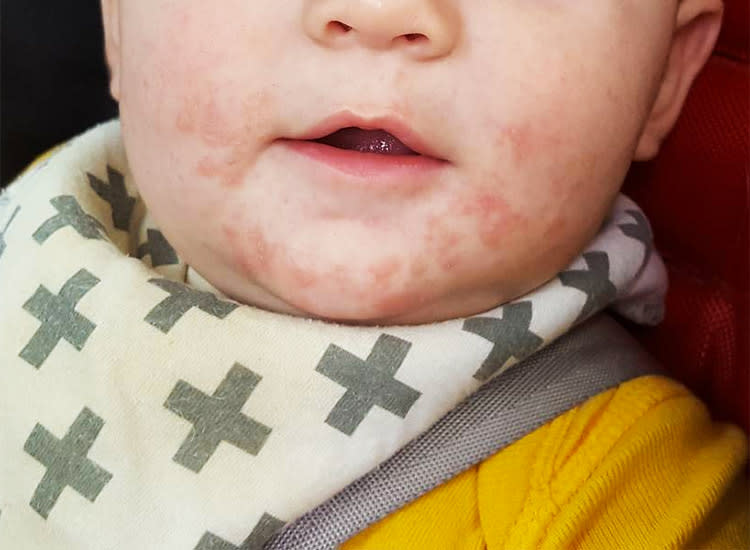
Image: Courtesy of Wissabo/Instagram
Baby drool rash symptoms
• A red, irritated baby rash on the face. Because the skin around baby's mouth, chin and neck is constantly wet, these areas are especially prone to drool rash.
• Flaking skin. Baby rash from drool can also appear slightly flaky and dry-looking.
Prevention and treatment
One way to prevent and heal a baby rash caused by drool? Have a soft bib handy to keep the skin on baby's face and chest dry. Apply a gentle over-the-counter ointment before and after meals as a barrier to prevent saliva from touching the skin, so baby's drool rash can heal underneath it.
Baby Eczema Rash
Eczema, often-chronic red, dry patches of skin, is one of the most common skin disorders in babies—in fact, 60 percent of infants get eczema in the first year of life. "Sometimes babies scratch so much, it can lead to bleeding and can interfere with sleep," Bender says. "Babies with eczema often scratch more in the evening when they're put to bed or at night when they aren't distracted by other activities." Eczema can get infected if not treated, leading to scabbing and oozing skin spots.
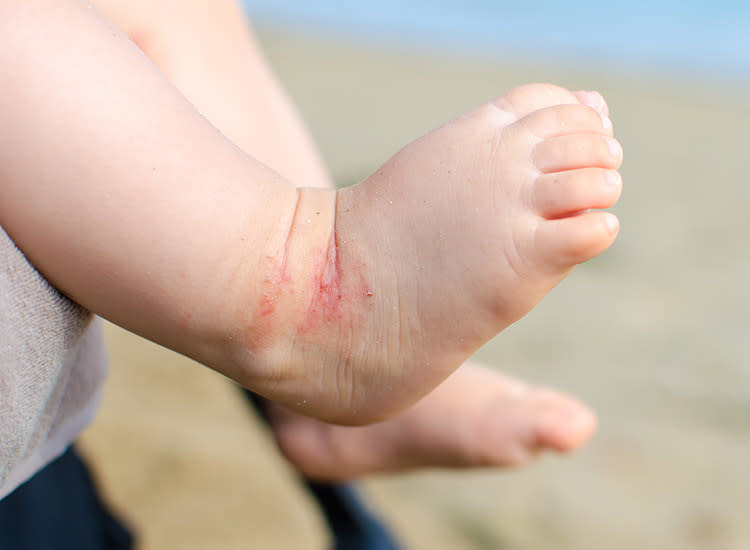
Image: iStock
Baby eczema symptoms
• Itchiness. The more severe baby's eczema is, the more itchy the rash. • Dry skin patches. This is a common sign of mild eczema.
• Pinker patches of dry, flaky skin. This signifies a moderate case of eczema.
• Red, flaky patches of skin. If baby's skin is a darker red, it signifies severe eczema, which usually comes with worsened symptoms and intense itchiness across more of the body.
Prevention and treatment
Keeping baby's skin well moisturized with a daily application of a thick cream can prevent the onset of eczema in infants who are at higher risk for the condition—aka those who have a strong family history of eczema or eczema-related diseases. A mild case of this baby rash can sometimes be treated with just moisturizer, while moderate eczema may need a cortisone cream or ointment to treat it. Severe eczema is treated with over-the-counter products.
Hives
"Hives can occur soon after baby eats something they're allergic to or if baby is fighting a virus, in which case the hives may last for several days off and on," Bender says. They can appear anywhere on the body, even if caused by food. If the baby rash is sparked by something your child touched, it usually appears on the part of baby's body that came in contact with the allergen. If hives are accompanied by wheezing or if baby's mouth or tongue starts to swell, see a doctor immediately.
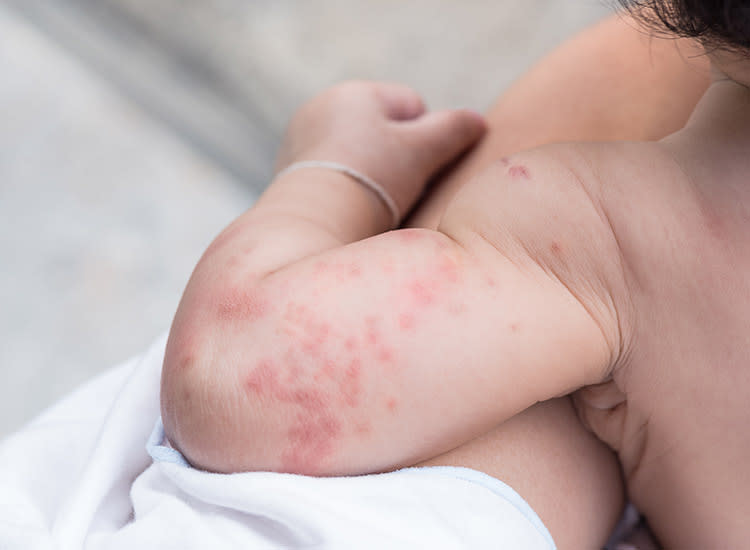
Image: Shutterstock
Hive symptoms
• Pink, blotchy welts. These welts can come and go on baby's skin.
• Itching. Hive welts are often very itchy.
Prevention and treatment
An oral antihistamine, such as Benadryl, can help treat hives. For a more natural remedy, try dabbing calamine lotion on the welts to soothe hives.
Baby Allergy Rash
As you expose baby to new products, foods and materials, there's always a small chance they could be allergic to a certain ingredient or chemical. These rashes can be caused by food or medication that baby's allergic to, or when baby's skin comes into contact with an irritant, Crosby says.
So what does an allergy rash look like on a baby? A baby allergy rash can manifest in different ways, but the two most common signs are hives and eczema. As mentioned above, hives usually show up as pink blotchy welts, while eczema appears as red, dry, flaky patches. Both rashes are itchy.
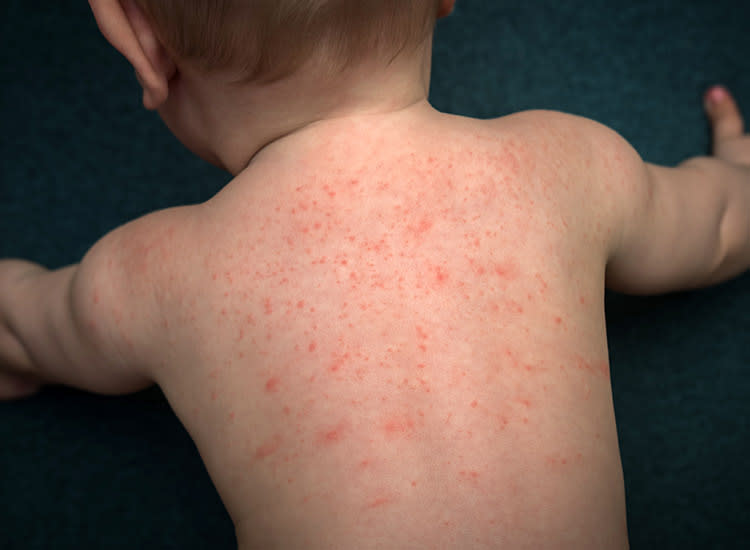
Image: Shutterstock
Allergy symptoms
If you notice the following symptoms, take baby to the ER:
• Swelling of the lips or face. If baby's lips or face become swollen, it's a sign of a severe allergic reaction and should be treated by a doctor immediately.
• Wheezing. Any sign of difficulty breathing is a red flag.
Prevention and treatment
"Treatment depends on the age of the child and what is triggering it," Crosby says. "You want to remove the allergen or trigger if you can, and use a topical or oral allergy medicine." Sometimes a blood or skin test might be needed to figure out what baby is having an allergic reaction to, and then a baby rash treatment can be prescribed.
Baby Fungal Rash
A fungal baby rash is often caused by chronically wet or irritated skin. A yeast infection is the most common type of fungal rash. It can also appear in babies if another family member or family pet has ringworm.
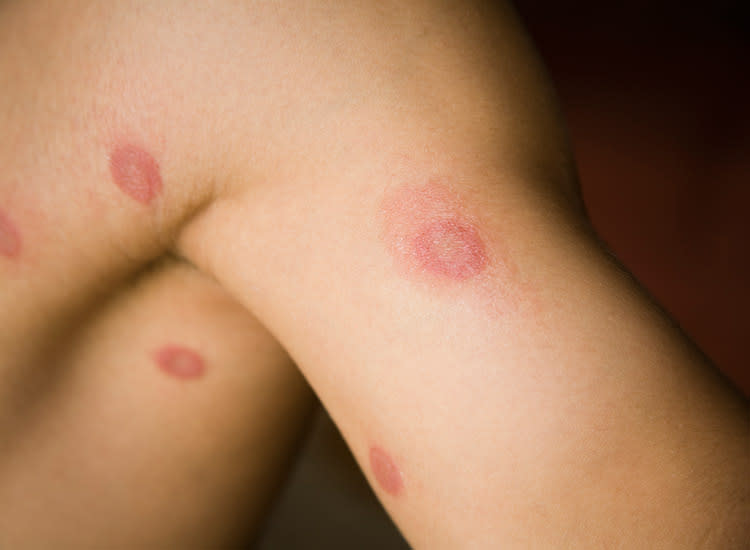
Image: iStock
Fungal rash symptoms
• Pink, ring-like flaking patches of skin. These flaky patches can pop up anywhere on the skin, including the scalp and diaper area.
Prevention and treatment
"A fungal rash needs a special antifungal cream, or if it's on the scalp and hair, it may need an oral antifungal medication," Bender says. To prevent fungal baby rash, keep the skin clean and dry.
Cradle Cap
Essentially dandruff for babies, cradle cap is relatively common and typically caused by yeast. This type of baby rash usually shows up in the first month of life but can occur any time, Crosby says.
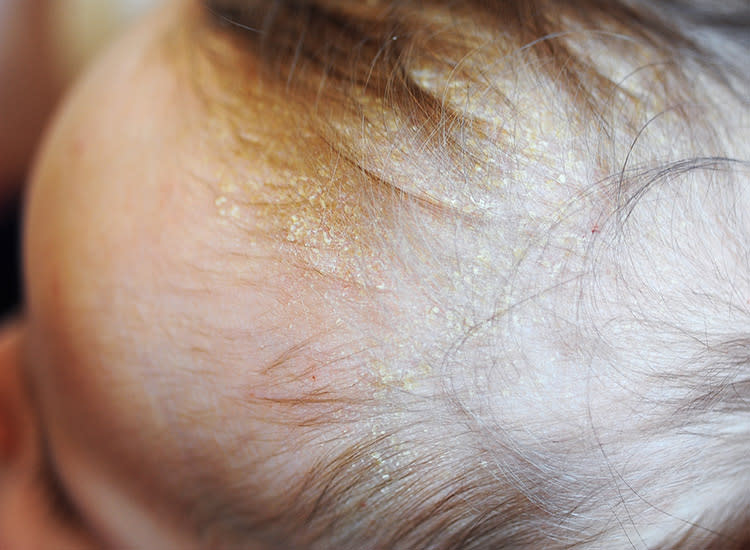
Image: iStock
Cradle cap symptoms
• Flaky skin. Rough, yellowish or pink crustry or oily scaly patches on the scalp are a classic sign of this type of baby rash.
•A slight oily scent. This results from the buildup of oil on baby's scalp in moderate to severe cases.
Prevention and treatment
Most cases of cradle cap can be treated with regular shampooing and a soft scalp brush to loosen the flakes. If that doesn't cut it, your pediatrician may recommend a medicated shampoo.
In general, the trick to preventing baby rash is keeping your child's skin healthy. It's best to keep baths to 10 minutes or less and use lukewarm water, since "during a bath, skin can really lose moisture, and babies are much more prone to getting dry skin," Crosby says. Hydrating baby's skin regularly is crucial. The best time to apply lotion? The first five minutes after a bath, to lock in moisture. "The skin is the largest organ in the body and it's there to protect us from the elements and infections," Crosby says. "The importance of really caring for it from infancy through adulthood can't be stressed enough."
Do baby's lumps or bumps not line up with any of those listed in this guide? Baby can also develop a rash as a result of bug bites, sunburns, poison ivy and even dry skin. If you're still not sure about baby's rash, don't hesitate to give your pediatrician a call or schedule an appointment.
When to Be Concerned About Baby Rashes
Now that you are familiar with some of the most common kinds of baby rashes, you're probably wondering, "when should I be concerned about my baby's rash?"
The truth is, many baby rashes are harmless, and some will come and go on their own without any medical treatment. The other good news is that there are vaccinations to prevent many serious rashes from developing in the first place.
With that said, there are some signs you should keep an eye out for when you notice a baby rash on the body. Some baby rashes can indicate a potentially grave condition, particularly if the rash is persistent or if baby is experiencing swelling or wheezing.
Contact a doctor if baby experiences any of the following:
- If there is pain at the site of the rash
- If baby runs a fever
- If the rash develops bruise-like lesions
- If the rash oozes, bleeds or blisters
- If the rash continues to spread across baby's body
- If baby develops any cold symptoms (coughing, wheezing, etc.)
- If baby has swollen neck glands or swollen lips
- If the baby rash doesn't go away after two days
It's true babies tend to get rashes left and right, but that doesn't mean you should shrug them off as nothing. Whenever you notice a baby rash on their face or body, keep a watchful eye on it and look out for other symptoms. When it comes to baby's health, it's always best to be precautious and proactive.
About the experts:
Anna Bender, MD, is a pediatric dermatologist at Weill Cornell Medicine and New York-Presbyterian. She earned her medical degree from Columbia University College of Physicians and Surgeons in 2007. After completing her residency training in dermatology at New York Presbyterian Hospital - Weill Cornell Medical Center, Bender completed an additional year of specialized fellowship training in pediatric dermatology at the Johns Hopkins University School of Medicine.
Lauren R. Crosby, MD, FAAP, is a parenting expert and pediatrician at LaPeer Pediatrics in Beverly Hills, California. She earned her medical degree at UCLA School of Medicine and afterwards trained at Cedars-Sinai Medical Center, during which time she served as chief resident. She is a member and official spokesperson of the American Academy of Pediatrics.
Please note: The Bump and the materials and information it contains are not intended to, and do not constitute, medical or other health advice or diagnosis and should not be used as such. You should always consult with a qualified physician or health professional about your specific circumstances.
Plus, more from The Bump:
Small Red Bump on Baby Shoulders and Face.
Source: https://www.thebump.com/a/baby-rash
0 Response to "Small Red Bump on Baby Shoulders and Face."
Post a Comment